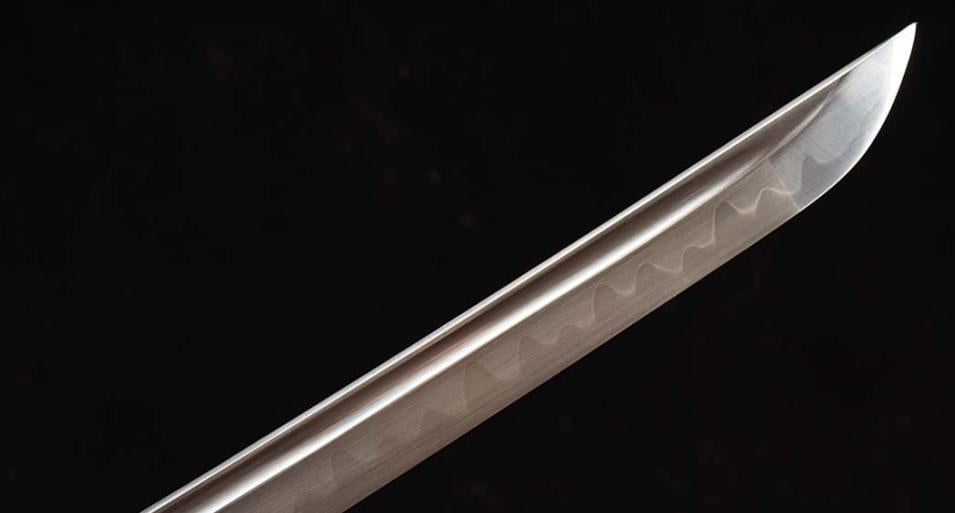T10 Steel Katana Explained: History, Craftsmanship & Collector’s Guide

Is a T10 Steel Katana worth collecting? Historical background, forging techniques, and real combat performance explained.
In the world of sword enthusiasts and martial arts collectors, the T10 Steel Katana is highly regarded for its outstanding hardness, sharpness, and historical significance. Whether you are a fan of traditional Japanese swords or a collector of high-end display pieces, the T10 Katana attracts great interest. This article explores the history, steel properties, traditional craftsmanship, design, and practical applications of the T10 Katana, while incorporating keywords such as 'T10 Steel Katana price,' 'T10 folded forging,' and 'T10 Katana collector’s value' to help enthusiasts gain a comprehensive understanding of this iconic sword.
I. The Historical Origins of the T10 Steel Katana
1. The Traditional History of the Samurai Sword
The Japanese katana has existed for centuries as a symbol of samurai spirit and Bushido culture. From the earliest straight swords (Chokuto) to the refined curved blade (Katana), every sword was not just a weapon but also a reflection of identity, honor, and philosophy. Ancient samurai considered their swords 'the soul’s companion,' representing loyalty, courage, and moral discipline.
Over time, Japanese swordsmiths developed legendary forging methods such as multi-layer folding (Honsanmai), hamon temper line creation, and clay tempering, which balanced sharpness and durability while giving blades unique aesthetic patterns. Thus, the katana became the perfect fusion of artistry and battlefield performance.
The T10 Katana is a modern representation of this legacy. It maintains the traditional proportions, curvature, and handling of Japanese swords while utilizing the advantages of modern metallurgy. This allows practitioners and collectors to enjoy the cultural weight of tradition along with the durability and sharpness of advanced steel.
2. The Status of T10 Steel
T10 steel is a high-carbon tungsten alloy steel, inspired by advanced German tool steels. Known for its hardness, toughness, and wear resistance, it has become a favored material for high-end handmade katanas, training swords, and collectible blades.
Unlike traditional steels, T10 maintains razor sharpness while enduring long-term use and heavy strikes without breaking or bending. Swordsmiths typically employ precise forging and repeated folding techniques, echoing the craftsmanship of ancient Japan. By heating, hammering, folding, and quenching, smiths eliminate impurities, refine the grain, and form distinctive hada grain patterns that enhance both beauty and functionality.
Clay tempering further strengthens the edge while preserving spine flexibility, achieving a balance between sharpness and resilience.
Thus, the T10 Katana combines cultural tradition, practical performance, and collectible value, making it ideal for cutting practice, martial demonstrations, or display as a work of art.
II. Properties of T10 Steel
Is T10 steel good for katana?
Yes—T10 steel is an excellent choice for katana forging. As a premium high-carbon steel, T10 is widely used in modern sword-making for its exceptional balance of hardness, toughness, and durability. Below is a detailed analysis:
1. High Hardness & Sharpness
With a Rockwell hardness of HRC 58–62, T10 blades achieve extraordinary sharpness. They cut through bamboo, tatami mats, wood, or rope with ease, while holding an edge for extended use. Unlike standard carbon steels, T10 resists dulling, making it ideal for cutting practice and stage combat swords.
This superior hardness gives the T10 Katana unmatched cutting power, ensuring precise strikes in martial practice.
2. Excellent Toughness
High hardness often leads to brittleness, but T10’s alloy composition and heat treatment provide remarkable resilience. T10 blades resist cracking, bending, or chipping even under intense impact or heavy use.
This toughness makes them suitable for daily training, cutting demonstrations, and long-term collection without structural damage.
3. Corrosion Resistance
While high-carbon steels are usually prone to rust, T10 undergoes advanced quenching and tempering to enhance oxidation resistance. With proper oiling and cleaning, the blade maintains its polish and sharpness for years, making it a reliable choice for collectors and practitioners alike.
4. Practical Applications
Overall, T10 combines sharpness, durability, toughness, and corrosion resistance, making it a premium material for modern katanas, handmade swords, and martial practice weapons. Whether for real cutting practice, martial arts, or display, a T10 Katana delivers a perfect blend of functionality, aesthetics, and heritage.
III. The Craftsmanship of the T10 Steel Katana
A high-end T10 Katana is more than its steel—it embodies ancient traditions, modern precision, and artistic beauty. From edge sharpness to durability, every detail reflects master-level skill.
1. Hand Forging & Multi-Folded Construction
Premium T10 blades are hand-forged and repeatedly folded, a method inherited from Japan’s Warring States period.
Steps include:
-
Heating & Forging – Heating T10 to ~1200°C for hammer shaping.
-
Folding & Hammering – Repeated folding to remove impurities, refine the structure, and improve strength while creating unique hada patterns.
-
Shaping & Polishing – Crafting the signature curve, adjusting balance, and sharpening the blade.
Each fold infuses tradition into the steel, making every sword unique—both a weapon and a piece of art.
2. Clay Tempering (Hamon Creation)
Clay tempering is essential to achieve the classic hard edge with a flexible spine and the famous hamon temper line.
Steps include:
-
Applying Clay – Thin layer on the edge, thicker on the spine.
-
Heating – Red-hot heating for structural alignment.
-
Quenching – Rapid cooling, hardening the edge while keeping the spine flexible.
This process ensures a razor edge, superior toughness, and an elegant hamon that represents both functionality and artistry.
3. Fusion of Tradition & Modern Technology
Today’s swordsmiths blend ancient Japanese techniques with modern precision tools, ensuring consistent sharpness, balance, and durability.
Every T10 Katana thus offers:
-
Historical authenticity – Preserving the spirit of Bushido
-
Practicality – Sharp, tough, and perfect for training
-
Artistry – Unique hada and hamon patterns, making each blade collectible
IV. Design and Practical Applications of the T10 Steel Katana
A T10 Steel Katana is not only a razor-sharp weapon but also an artistic creation that blends historical aesthetics, ergonomics, and modern sword craftsmanship. Whether for martial arts demonstrations, cutting practice, or high-end collecting, the T10 Katana meets the diverse needs of sword enthusiasts.
1. Classic Blade Style and Structure
Premium T10 katanas follow the traditional proportions of Japanese swords:
-
Curved Blade – The elegant curvature supports quick draw cuts (Iaido) and maintains accuracy and balance in continuous strikes.
-
Tsuka (Handle) Design – Typically wrapped in genuine ray skin (Samegawa) with cotton or silk ito (cord wrap), ensuring a comfortable, non-slip grip that remains durable during long practice sessions.
-
Saya (Scabbard) – Usually made from lacquered hardwood in black or deep tones, providing both blade protection and elegant display value. High-end models may feature carved motifs, adding artistic flair.
This design balances combat effectiveness, handling comfort, and visual appeal, making T10 katanas both functional and collectible.
2. Cutting Performance and Practical Use
The T10 Katana’s high hardness and excellent resilience make it ideal for martial practice and tameshigiri (cutting demonstrations).
-
Precise Strikes – Balanced blade geometry ensures fast, accurate cutting against bamboo, tatami mats, or rope.
-
Toughness – Despite its sharpness, the T10 blade resists breaking or bending under intense practice.
-
Fluid Motion – The blade curvature and ergonomic handle support smooth, natural transitions between draw, swing, and cut—ideal for kata practice and performance.
Thus, a T10 Katana is not just for display—it is a fully functional, high-performance sword.
3. Collectible and Display Value
Because each T10 Katana is made through hand forging, folding, and clay tempering, no two are exactly alike.
-
Collector’s Value – The superior steel and master craftsmanship make it highly sought after in the sword collector’s market.
-
Display Appeal – Visible hada grain and hamon temper line, combined with ornate saya and tsuka designs, make it a striking centerpiece for any collection.
-
Cultural Symbolism – More than a weapon, it represents samurai spirit, fine craftsmanship, and cultural heritage, making it especially popular with anime fans and Japanese sword culture enthusiasts.
In short, the T10 Katana is prized for practical training, martial demonstrations, and cultural collection.
V. Buying Guide for T10 Steel Katanas
-
Price Range – Premium handmade T10 blades typically range from $450 to $2,000+, depending on craftsmanship and smith reputation.
-
Care & Maintenance – Avoid moisture exposure; apply oil regularly to prevent rust and preserve the blade.
-
Best Suited For – Collectors, martial artists, anime fans, and buyers seeking luxury cultural gifts.
Handmade Japanese Tachi Sword – Oda Nobunaga Edition
The Handmade Japanese Tachi Sword, Oda Nobunaga Edition, combines historical tradition with modern craftsmanship. The blade is hand-forged from premium T10 high-carbon steel, clay tempered for a hardness of HRC 58–62, offering razor sharpness while maintaining excellent resilience.
Its proportions follow the traditional Tachi style—longer and more curved than the katana—ideal for slashing strikes and elegant display. The tsuka is wrapped in genuine samegawa (ray skin) with silk cord ito, providing a comfortable and secure grip, faithfully recreating the feel of ancient samurai swords.
The saya is crafted from lacquered cypress wood, smooth and refined, protecting the blade while serving as a beautiful display piece. This sword is not only suitable for martial practice and stage performance but also a must-have for serious collectors, samurai culture enthusiasts, and anime fans.
Product Highlights
-
Premium Steel – T10 high-carbon steel, clay tempered, razor-sharp and durable
-
Hand Forged – Folded construction with unique hada grain and visible hamon temper line
-
Ergonomic Tsuka – Wrapped in genuine ray skin for firm grip
-
Elegant Saya – Lacquered cypress wood, balancing display and protection
-
Historical Authenticity – Faithful to the Tachi style of Oda Nobunaga’s Warring States era
Whether for martial arts training, stage demonstrations, or elite collection and display, the Oda Nobunaga Tachi delivers the perfect union of historical legacy, master craftsmanship, and samurai spirit.
VI. Conclusion: The Enduring Allure of the T10 Katana
The T10 Steel Katana is far more than a sharpened blade—it is the embodiment of history, craftsmanship, and culture. Preserving the spirit of the Japanese samurai while leveraging the strength of modern steel, it allows both collectors and practitioners to experience the beauty and power of the sword.
Whether for martial training, performance, or cultural collection, the T10 Katana remains an irreplaceable classic choice.









